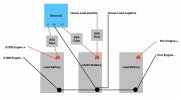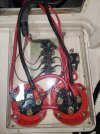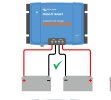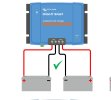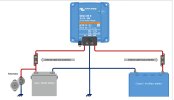- Joined
- Oct 11, 2023
- Messages
- 999
- Reaction score
- 220
- Points
- 43
- Age
- 61
- Location
- Island of Sardinia
- Model
- Canyon 306
Yesterday i finished the installation of my LiTime 140Ah LiFePo house battery and changed 2+1 battery setup to 1+1+1 battery setup.
GW cabled my 306 Canyon (afaik many other models too) with stbd engine and house battery in parallel what is a way to do it, but not the way i am used to and prefer.
However it works for many and makes the use of battery switches simpler as there are only two needed and i don't want to start a tread if this is right or wrong.
When replacing the lead-acid house battery with a LiFePo/LFP battery the parallel engine and house battery will not work anymore so some modifications in cabling are needed.
The reason for that is that LiFePo should not be connected in parallel with other chemistry batteries, same as different Ah and/or type lead-acid batteries.
Surprisingly it was more easy to do as i expected, most time i lost was to put some order in the cable mess previous owners have made and still a lot to do.
What you need to start and finish this job is:
The reason to use one is that LiFePo batteries can pull a massive amount of amps when charging and this may damage the outboard/s charging system.
The Victron Orion series limits how much ampere the battery can draw , Orion-Tr to a fixed amount while the Orion XS can be programmed freely between 1-50A and he heats up much less than the Orion-Tr series.
There are many emotionally treads in forums regarding if it's necessary or not to use a DCDC charger between LiFePo and charging system and i don't want to go in that.
My new Honda BF350 outboards have automobile kind alternators and it seems that they react more sensible to high power demand than the usual flywheel driven outboard alternators. Same is probably true for owners with onboard generators!
For me its fine to invest 300$ for the Victron Orion XS and have peace of mind that i can program it to a correct power draw and correct output amps for the LiFePo used.
There are other brands who produce DCDC chargers, i choose Victron as they have a lot of experience in marine/home/solar power regulating devices and are very common here in Europe.
Chris
GW cabled my 306 Canyon (afaik many other models too) with stbd engine and house battery in parallel what is a way to do it, but not the way i am used to and prefer.
However it works for many and makes the use of battery switches simpler as there are only two needed and i don't want to start a tread if this is right or wrong.
When replacing the lead-acid house battery with a LiFePo/LFP battery the parallel engine and house battery will not work anymore so some modifications in cabling are needed.
The reason for that is that LiFePo should not be connected in parallel with other chemistry batteries, same as different Ah and/or type lead-acid batteries.
Surprisingly it was more easy to do as i expected, most time i lost was to put some order in the cable mess previous owners have made and still a lot to do.
What you need to start and finish this job is:
- one LiFePo battery what fit the battery compartment space
- one ampere draw limiting DC-DC charger (i used the Victron Orion XS)
- one ON-OFF battery switch for the new LiFePo battery
- 3 60A fuses (i used automatic ones)
- about 7 ft of 16 mm/6 AWG cable
- 6 AWG cable lugs with different hole size
- about 7ft 0/2 or 1 AWG cable to make battery cables, use the same size as battery cable coming from outboard
- a bag of screw on zip tie bases to secure the new cables
- cable lug crimper, cable stripper or cutter, scissors, heat shrink tubes, zip ties, etc
- a hexagonal cable ferrule crimper if you want to use ferrules, Victron write that they are not needed
- disconnect all cables from battery posts
- cover positive battery posts to avoid get zapped or remove them till you need to have measure the cables
- remove the battery switch box and disconnect the thicker now obsolete MAIN written on it house battery cable running from there to +12V bus bar under dash
- remove obsolete MAIN cable from +12V bus bar under dash
- mount DCDC charger, the 3 60A fuses and the battery switch in a convenient location
- start with routing the new cables, cut to length and crimp the correct size cable lug on the cable ends
- connect the cables to the respective bolts, double check if correct bolt is used
- connect battery post again, first +12V and then -12V
- switch on battery switch and fuses and all should work
- it is more work than expected and in my case in a uncomfortable position, use a kind of seat to stay more comfortable
- buy a Dymo label printer and stick on labels to mark what is what for later use and less confusion, before removal and while cables are connected
- take photos of the existing electrical system before you change something, that helps if doubts arise
- LiFePo batteries have usually 8mm bolts, not battery posts, so battery cable lugs should have 8mm hole size lugs
- Amazon sells pairs of battery posts with 8mm tread to use instead batteries 8mm bolt, i ordered them but have not arrived
- i left the disconnected and obsolete MAIN cable in place for hypothetic later use and taped off the lugs
- there is a small risk that the BMS of the LiFePo battery switch off the battery to protect her what will lead to no power on house devices a
On-1-2-ALL-OFF switch instead of a ON-OFF switch can be used and connect on 1 the LiFePo and on 2 the house battery so house power can be pulled from either LiFePo or from engine battery. - i mounted the battery switch on the inside of the panel, just beside the opening hatch as i don't wanted to drill thru the inside console panel.
yes, not very comfortable as i need to enter the console and open the hatch to turn the battery switch, but it's hidden and electronics box can't be opened without breaking the console door and then find the battery switch.
The reason to use one is that LiFePo batteries can pull a massive amount of amps when charging and this may damage the outboard/s charging system.
The Victron Orion series limits how much ampere the battery can draw , Orion-Tr to a fixed amount while the Orion XS can be programmed freely between 1-50A and he heats up much less than the Orion-Tr series.
There are many emotionally treads in forums regarding if it's necessary or not to use a DCDC charger between LiFePo and charging system and i don't want to go in that.
My new Honda BF350 outboards have automobile kind alternators and it seems that they react more sensible to high power demand than the usual flywheel driven outboard alternators. Same is probably true for owners with onboard generators!
For me its fine to invest 300$ for the Victron Orion XS and have peace of mind that i can program it to a correct power draw and correct output amps for the LiFePo used.
There are other brands who produce DCDC chargers, i choose Victron as they have a lot of experience in marine/home/solar power regulating devices and are very common here in Europe.
Chris
Last edited:


